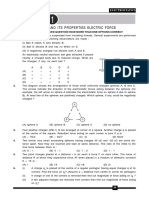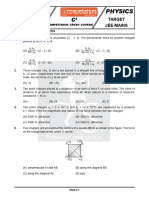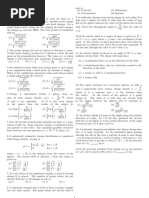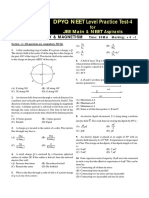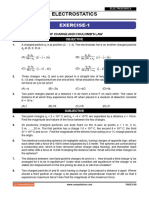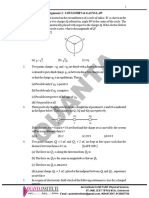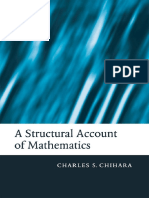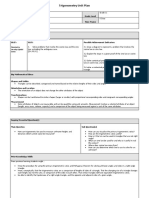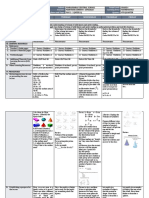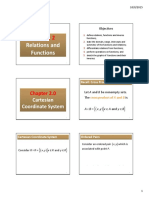Electric Charges and Field - DPP 03 (Of Lec 05) - Prayas JEE 2.0 2025
Electric Charges and Field - DPP 03 (Of Lec 05) - Prayas JEE 2.0 2025
Uploaded by
Apoorv AishwaryCopyright:
Available Formats
Electric Charges and Field - DPP 03 (Of Lec 05) - Prayas JEE 2.0 2025
Electric Charges and Field - DPP 03 (Of Lec 05) - Prayas JEE 2.0 2025
Uploaded by
Apoorv AishwaryOriginal Title
Copyright
Available Formats
Share this document
Did you find this document useful?
Is this content inappropriate?
Copyright:
Available Formats
Electric Charges and Field - DPP 03 (Of Lec 05) - Prayas JEE 2.0 2025
Electric Charges and Field - DPP 03 (Of Lec 05) - Prayas JEE 2.0 2025
Uploaded by
Apoorv AishwaryCopyright:
Available Formats
JEE
Prayas JEE 2.0 (2025)
Physics
DPP: 3
Elecrtic Charges and Fields
Q1 Three charges are placed at the vertices of an Q3 An infinite number of charges, each of charge
equilateral triangle of side ′a′ as shown in the 1 μC, are placed on the X-axis with co-
following figure. The force experienced by the
ordinates x ,
= 1, 2, 4 8, … … … . . If a
charge placed at the vertex A in a direction
charge of 1C is kept at the origin, then what is
normal to BC is:
the net force acting on 1C charge?
(A) 9000 N (B) 12000 N
(C) 24000 N
(D) 36000 N
Q4 Point charges +4q, −q and +4q are kept on
the x-axis at points x = 0, x = a and x = 2 a
respectively, then:
(A) only -q is in stable equilibrium
(B) none of the charges are in equilibrium
(C) all the charges are in unstable equilibrium
(D) all the charges are in the stable equilibrium
(A) Q2/(4πε a )
2
Q5 Two small spherical balls each carrying a
0
(B) −Q2/(4πε 2 charge Q =10 μC (10 micro-coulomb) are
a )
0
suspended by two insulating threads of equal
(C) zero
(D) Q2/(2πε 2
lengths 1 m each, from a point fixed in the
a )
0
ceiling. It is found that in equilibrium threads
Q2 Equal charges q are placed at the four corners are separated by an angle 60° between them,
as shown in the figure. What is the tension in
A, B, C, D of a square of length a. The
the threads?
magnitude of the force on the charge at B will
be:
(A) 3q
2
πε0a2
4
(B) 4q
2
4 πε0a2
(C) 1+2√ 2 q
2
( )
πε0a2 1
2 4
(Given: = 9 × 10
9
Nm /C
2
)
πε0)
(D)
(4
2
1 q
(2 + ) (A) 18 N
(B) 1. 8 N
√2 4 πε0a2
Android App | iOS App | PW Website
JEE
(C) 0. 18 N
(D) None of these (D) Q
(1 + 2√ 2)
2
Q6 Two equal charges are separated by a distance
Q9 A pendulum bob carries a negative charge - q.
d. A third charge placed on a perpendicular
A positive charge + q is held at the point of
bisector at x distance will experience
support. Then, the time period of the bob is:
maximum coulomb force when:
(A)
(A) d
greater than 2π√
L
x = g
√2
(B)
(B) L
x =
d
less than 2 π√ g
2
(C) d
(C) L
x = equal to 2 π√ g
2√ 2
(D) d
(D)
2L
x = equal to 2 π√ g
2√ 3
Q7 Three charges −q1, +q2 and −q3 are placed
as shown in the figure. The x-component of
the force on −q1 is proportional to:
(A) q2 q3
2
−
2
sin θ
b a
(B) q2 q3
2
−
2
cos θ
b a
(C) q2 q3
2
+
2
θ
sin
b a
(D) q2 q3
2
+
2
cos θ
b a
Q8 Four charges equal to −Q are placed at the
four corners of a square and a charge q is at its
centre. If the system is in equilibrium the value
of q is:
(A) Q
− (1 + 2√ 2)
4
(B) Q
(1 + 2√ 2)
4
(C) Q
− (1 + 2√ 2)
2
Android App | iOS App | PW Website
JEE
Answer Key
Q1 C Q6 C
Q2 C Q7 C
Q3 B Q8 B
Q4 C Q9 C
Q5 B
Android App | iOS App | PW Website
You might also like
- Appendix D Review of Mechanics of Materials - 2009 - Elasticity Second Edition PDFNo ratings yetAppendix D Review of Mechanics of Materials - 2009 - Elasticity Second Edition PDF14 pages
- Cambridge Secondary Checkpoint - Mathematics (1112) April 2020 Paper 2 Question86% (7)Cambridge Secondary Checkpoint - Mathematics (1112) April 2020 Paper 2 Question16 pages
- Electric Charges and Fields _ DPP 04(of Lec-09) _ Yakeen NEENo ratings yetElectric Charges and Fields _ DPP 04(of Lec-09) _ Yakeen NEE3 pages
- Electric Charges and Field - DPP 04 (Of Lec 07) - Prayas JEE 2.0 2025No ratings yetElectric Charges and Field - DPP 04 (Of Lec 07) - Prayas JEE 2.0 20253 pages
- Electrostatic Potential and Capacitance _ DPP 01(of Lec-02) __ Yakeen Neet 2025No ratings yetElectrostatic Potential and Capacitance _ DPP 01(of Lec-02) __ Yakeen Neet 20253 pages
- 12 - JM - P1 - M1 Q 1305CJM202021230001-Allen 070523No ratings yet12 - JM - P1 - M1 Q 1305CJM202021230001-Allen 07052316 pages
- Electrostatic Potential and Capacitance - DPP 08 (Extra DPP) - Lakshya JEE 2025No ratings yetElectrostatic Potential and Capacitance - DPP 08 (Extra DPP) - Lakshya JEE 20254 pages
- Electrostatic Potential and Capacitance DPP 01 Prachand NEET 2025 (1)No ratings yetElectrostatic Potential and Capacitance DPP 01 Prachand NEET 2025 (1)12 pages
- DPP 02 Electrostatic Potential & Capacitance Manzil JEE 2025No ratings yetDPP 02 Electrostatic Potential & Capacitance Manzil JEE 20256 pages
- Electric Charges and Fields Practice Sheet Uthaan NEET 2024No ratings yetElectric Charges and Fields Practice Sheet Uthaan NEET 20247 pages
- Electrostatic Potential and Capacitance _ DPP 03(of Lec-07) __ Yakeen Neet 2025No ratings yetElectrostatic Potential and Capacitance _ DPP 03(of Lec-07) __ Yakeen Neet 20253 pages
- Lakshya JEE (2025) : Physics Electric Charges and FieldsNo ratings yetLakshya JEE (2025) : Physics Electric Charges and Fields3 pages
- #NEET DPYQ Test Paper - 4 - Electricity & MagnetismNo ratings yet#NEET DPYQ Test Paper - 4 - Electricity & Magnetism8 pages
- Ts Neet-2019 QP Test-06 (Pmtcorner - In)No ratings yetTs Neet-2019 QP Test-06 (Pmtcorner - In)16 pages
- Essential Sheet Electrostatics Exercise-1 To 2No ratings yetEssential Sheet Electrostatics Exercise-1 To 224 pages
- WS 1 - COULOMB'S LAW & ELECTRIC FIELD DPSNo ratings yetWS 1 - COULOMB'S LAW & ELECTRIC FIELD DPS4 pages
- Electric Charges and Fields _ DPP 02(of Lec-05) __ Yakeen Neet 2025No ratings yetElectric Charges and Fields _ DPP 02(of Lec-05) __ Yakeen Neet 20253 pages
- Electrostatic potential and Capacitance _ DPP 03 __ Lakshya NEET 2.0 2024No ratings yetElectrostatic potential and Capacitance _ DPP 03 __ Lakshya NEET 2.0 20243 pages
- Questions - Rank Booster Package - ElectrostaticsNo ratings yetQuestions - Rank Booster Package - Electrostatics10 pages
- Studio 01: Fundamental of 2D Construction: 1. DIMENSION in InchesNo ratings yetStudio 01: Fundamental of 2D Construction: 1. DIMENSION in Inches3 pages
- Charles S. Chihara - Structural Account of Mathematics (2004)No ratings yetCharles S. Chihara - Structural Account of Mathematics (2004)394 pages
- Mathematics Class Viii Assignment MensurationNo ratings yetMathematics Class Viii Assignment Mensuration2 pages
- P3 Engineering - VES Help EN13445 C16 11LegSupports PDFNo ratings yetP3 Engineering - VES Help EN13445 C16 11LegSupports PDF3 pages
- Trigonometry Unit Plan: Title of Unit Grade Level Subject Time Frame Developed byNo ratings yetTrigonometry Unit Plan: Title of Unit Grade Level Subject Time Frame Developed by11 pages
- (Transactions of The American Philosophical Society Held at Philadelphia For Promoting Useful Knowledge, Volume 96 Parts 2 & 3) Alhazen (LBN Al-Haytham), 965-1039 - A. Mark Smith (Editor, TranslationNo ratings yet(Transactions of The American Philosophical Society Held at Philadelphia For Promoting Useful Knowledge, Volume 96 Parts 2 & 3) Alhazen (LBN Al-Haytham), 965-1039 - A. Mark Smith (Editor, Translation833 pages
- Dayananda Sagar Academy of Technology and Management Department of Computer Science & EngineeringNo ratings yetDayananda Sagar Academy of Technology and Management Department of Computer Science & Engineering2 pages
- GE6253 - ENGINEERING MECHANICS - Unit 5 Rigid Body Dynamics - LECTURE NOTESNo ratings yetGE6253 - ENGINEERING MECHANICS - Unit 5 Rigid Body Dynamics - LECTURE NOTES36 pages
- Exploded Views in Assemblies Solidworks 2016No ratings yetExploded Views in Assemblies Solidworks 201616 pages











